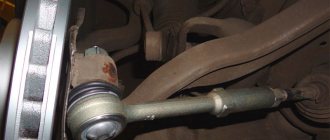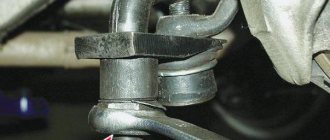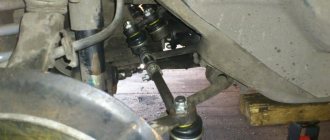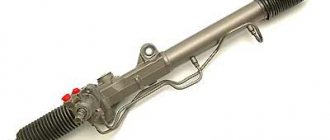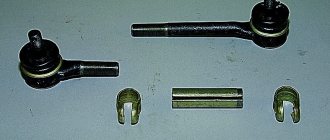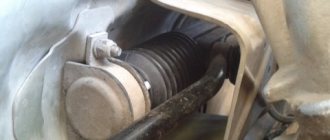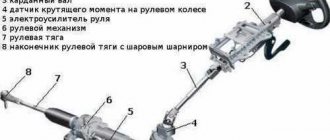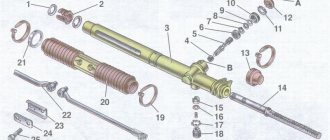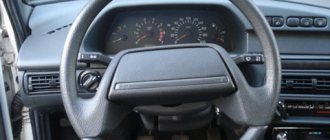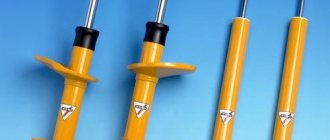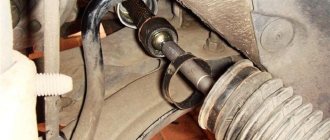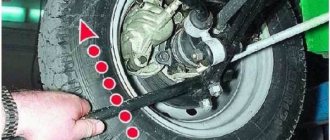Many motorists have encountered the fact that the steering tips on the VAZ-2114 failed. Of course, as practice shows, failure does not occur in pairs one at a time. This may be accompanied by natural wear and tear or falling into a pothole, of which there are quite a few on domestic roads.
Video about replacing steering tips on VAZ cars:
The video will tell you about the process of replacing steering ends on a car, as well as some of the subtleties and nuances of the procedure.
Symptoms of a problem
The first enemy of VAZ 2114 tips is dirt. They are a hinged element, so breaking the integrity of the boot causes solid particles to enter the mechanism. Due to friction, increased wear of the part and destruction of moving elements occurs.
The second “killer” is bad roads. Constant impacts from driving over bumps have an extremely bad effect on the condition of the part: the hinge wears out and vertical play occurs.
Defective parts must be replaced immediately.
People often ask what signs indicate that a tip needs to be changed. It is easy to check their condition. Turn the wheel all the way in one direction and carefully remove dirt from the boot. If breaks are visible or the rubber is cracked over time, the part needs to be replaced. Repeat the operation for the second wheel.
Even if there are no visible integrity problems, insert a pry bar between the rod and the steering knuckle and try to move them relative to each other. There should be no vertical play. If it is present, the part needs to be replaced.
Selecting new trapezoid parts
Since the VAZ 2107 car has been discontinued, finding original spare parts is becoming increasingly difficult. On the roads of the CIS countries, steering rods fall into disrepair quite often, so the supply of “original” parts has long been exhausted. In recent years, trapezoid kits have been supplied to the market by several well-known manufacturers:
- "Belmag";
- "Cedar";
- "Track";
- Fenox;
- Delphi;
- "VIS".
A special feature of repairing a steering linkage is that worn tips can be replaced one by one. Few Zhiguli owners install complete sets because of one broken ball pin. As a result, the “seven” trapezoid is often assembled from spare parts from different manufacturers.
Complete kit includes rods, clamps and castle nuts with cotter pins
The quality of steering rods from these manufacturers is approximately the same, as evidenced by reviews from car enthusiasts on the forums. Therefore, choosing a new spare part comes down to following 3 rules:
- Beware of fakes and do not buy parts from dubious outlets.
- Avoid tie rods from unknown brands sold at bargain prices.
- Do not confuse the left long tip with the right one if you are changing part of the trapezoid.
Preparing for replacement
Car service specialists recommend starting to spray the fastening nuts with WD-40 or other penetrating liquid a few days before the planned replacement of the tips.
If the tips on your VAZ 2114 have come off for more than one winter season, the main difficulty will be removing them from the steering knuckle. To unscrew the nut, you will need a wrench with a “17” head.
If the nut is very stuck, the solution will be to heat the connection with a hair dryer or a gas torch.
The question often arises about how to remove the tip from the hole in the steering knuckle. There are two methods of removal: the old one (with a sledgehammer) and the modern one (with a puller).
For the first method, you need to turn the steering wheel all the way and hit the steering knuckle hard several times. The vibration should cause the tip to pop out.
Disadvantages of this method:
- skill is required to deliver an accurate and strong blow;
- some experienced car owners claim that by acting in this way, you can shorten the life of the steering rack.
It is better to replace the tip using a puller. A puller for the VAZ 2114 will cost only 250-300 rubles, but will save you from many of the difficulties of replacement now and in the future.
Prices for tie rods per pair:
- Track - 620 rub.
- AvtoVAZ - 620 rubles.
- VIS - 730 rub.
- LEMFOERDER — 830 rub.
- FINWHALE — 860 rub.
Required Tools
To replace the steering tip, you must prepare the following tools and accessories:
- jack;
- a wheel wrench for unscrewing the wheel mounting bolts;
- hammer;
- crowbar or pry bar;
- metal brush for cleaning parts;
- WD-40 lubricant;
- calipers;
- set of heads and open-end wrenches;
- graphite lubricant.
Experienced motorists carry this set of tools in the trunk; it can come in handy on the road.
Repair procedure
The replacement algorithm includes several points:
- Jack up one side, remove the wheel, turn the steering wheel so that the tip is in a position convenient for replacement.
- Spray the connections with penetrating liquid.
- Unscrew the fastening nut.
- Pull the tip out of the hole in the steering knuckle.
- Check the condition of the steering rods and replace them if necessary.
- Replace the part.
- Reassemble in reverse order, repeat operations for the other wheel.
Service technicians are interested in what measures can be taken to protect threaded connections from dirt and moisture. The main thing is to thoroughly lubricate the threads with graphite lubricant or lithol. Some additionally put a tube of a suitable size at the junction of the rod and the tip or use heat shrink.
After replacing the VAZ 2114, it is best to adjust the wheel alignment. There is a way to avoid this though.
When removing the old tip, count the number of turns, and then tighten the new one by the same number. Then, when driving at low speed, make sure that the car does not drift sideways when the steering wheel is straight.
Adjustment
The adjustment is performed in this way: you can remove the rack from the vehicle or adjust it on it. The first method is used after repairing the machine, before installation. To simply adjust the rack, the work is done directly on the machine.
Tightening the rack with a key
To carry out the work, you must have a 17 mm universal octagon and an adjustable wrench. All work related to troubleshooting is carried out on a lift or inspection pit:
- First, the car must be put on the handbrake, some kind of support must be placed on the rear wheels;
- Then you need to lock the steering wheel and turn off the power to the car’s on-board network (remove the negative terminal from the battery);
- Then you need to find the nut with which the steering rack is adjusted. It is located on the opposite side, facing the body, of the rack mounting side. Sometimes it is mistaken for another part;
- First you should wash the bottom of the car. In this case, use a suitable device (Kärcher, for example). This is done in order to clean the nut from a layer of dirt. After cleaning the part from contamination, a wrench is inserted into it to tighten the rack and its position is adjusted. The tool rotates clockwise.
Thus, the adjustment is considered complete. If, after the work done, the control of the car is unsatisfactory, the play and knocking does not disappear, you should check the condition of the steering tips; they may need to be replaced.
What are the best steering tips for the VAZ 2114
Tie rod ends are steering control elements that are present on every modern car. The VAZ 2114 model was no exception.
The purpose of the tie rod ends is to provide a connection between the linkage and the steering knuckle of your car's wheel. When the tips move, the steering rack rods move, turning the wheel. In essence, steering tips provide the ability to make maneuvers, turns, and change the direction of movement of the car.
Element appearance
How to check the ball joint on your car
In more than a hundred years since the appearance of the first cars, thousands of changes have been made to their design. In the pursuit of perfection, developers rejected some technical solutions and replaced them with others.
Gradually, step by step, a modern car was formed, consisting of many components and assemblies, the reliability of which has been tested over the years. One of these units is the ball joint.
This detail has taken root in the chassis design of many cars. Technologically simple and reliable, it provides the car wheel with a high degree of mobility. Its serviceability is equally important for the operation of both the suspension and steering.
Signs of breakdown
Tie rods have two main enemies.
- Dirt. PH are hinged parts, therefore, when the boot is damaged, various solid particles of debris, dust, and dirt begin to enter the mechanism. Friction occurs, parts begin to wear out faster, and moving components are destroyed.
- Bad roads. How many bumps, holes, curbs do you have to overcome every day? All these impacts negatively affect the condition of the tips - the hinge begins to actively wear out, and play occurs in the vertical direction.
If a tip is found to be faulty, it must be replaced. It is better not to do with restoration and restoration of functionality.
Many people are interested in the question of how you can check the steering tips and make sure they are worn out or, on the contrary, intact. It is not necessary to go to a service station and pay money for this.
To check the condition of the LV, you need to turn the wheel all the way in one direction and remove all dirt from the boot. If there are breaks or cracks in the rubber, then the part has worn out and no longer performs its functions properly. Do subject to replacement. The second wheel is checked in a similar way.
There is one more important measure that is recommended to be carried out even if there are no signs of wear on the launch vehicle. To do this, a pry bar is inserted between the steering knuckle and the rod, after which the parts are moved relative to each other. If no vertical play occurs during these manipulations, everything is fine. If it is, you will definitely have to change the component.
When to change
how to adjust the clutch on a Priora if there are not enough threads. It is important for the motorist to know.
The structure of the elements is such that they are located at the ends of the steering rods. Hence the name - tips.
The rods themselves have a fairly impressive service life, so they are changed quite rarely. The same cannot be said about the tips.
If you follow the instructions provided in the instruction manual, then replacement should be performed approximately every 40 thousand kilometers. But still the figure is average. Depending on the situations, operating conditions and the quality of the currently installed elements, repairs may be required later or earlier.
The following factors influence the degree of wear of steering system components:
- Vehicle operating conditions;
- The quality of the tips used;
- Driving style of the car owner;
- Quality of roads, etc.
Signs of breakdown
At the first signs of a malfunction of the limit switches, appropriate measures should be taken to eliminate them.
You can determine that the elements are damaged and no longer perform their job as efficiently as before by the following characteristic signs:
- The car is difficult to control. This is especially noticeable when entering sharp turns;
- On tires, the tread pattern begins to wear unevenly;
- Uncharacteristic sounds are heard from the front of the car. Moreover, they can come from one side or from two simultaneously.
These signs of breakdown may indicate not only faulty steering tips. Therefore, mandatory verification is required.
Rubber boot
Preparatory activities
Many experts advise taking certain steps to prepare for the replacement so that everything goes easier and faster. These actions include the following.
- Treat all nuts and fasteners with penetrating liquid. WD40 works great.
- If the tips last longer than one winter, to remove their fist you will need to use a 17 socket to unscrew the nuts.
- If the nuts stick, try heating them with a hair dryer. A gas burner is also suitable, but you need to be as careful as possible with it.
- Prepare tools for removing tips.
Today, two methods are used to dismantle steering tips - modern and traditional. The first involves the use of a special puller, and the second - a sledgehammer.
Jack and WD40 at the ready
The traditional dismantling method involves the following actions:
- The steering wheel is turned all the way;
- Several strong blows are applied to the steering knuckle;
- Vibration causes the tip to pop out.
But the method has two serious drawbacks.
- It will take special skill to deliver precise, but at the same time accurate and strong blows.
- This method can reduce the service life of steering racks.
Therefore, the best option is a puller. You can literally buy it for 200-300 rubles, but it will be useful in the future and will significantly preserve the integrity of the remaining parts when replacing the launch vehicle.
Dismantling works
Replacement
The replacement procedure is quite simple. Especially if you have prepared the connecting elements in advance and acquired a puller.
- Using a jack, lift one of the sides where you will begin to change the tips.
- Turn the steering wheel to such an extent that it is convenient for you to replace damaged elements.
- Treat the elements again with a penetrating liquid.
- Unscrew the fastening nut.
- Remove the tip from the steering knuckle hole. Here you just need a puller or the traditional old-fashioned method using a sledgehammer.
- Check the condition of the steering rods. Sometimes it is better to replace them in the first couple of wears. Besides, you still got into this knot.
- Replace damaged tips with new ones.
- Perform the reassembly procedure.
Assembly
- Do the same with the second wheel.
- We recommend that you think additionally about protecting threaded fasteners from moisture and dirt. To do this, the threads can be lubricated with lithol, graphite grease, a tube of a suitable diameter can be put on, or heat shrink can be used.
- After completing the replacement of the steering tips, visit a service station to adjust the wheel alignment.
- If you don’t want to go to a service station, then count in advance the number of revolutions when removing the old tip. The new one is twisted by the same number of revolutions.
- Drive onto a straight road and check whether the car does not skid to the sides when driving in a straight line.
One of the main conditions for a successful replacement is the choice of quality parts.
New part
What to choose
Finally, we will present several options for the most popular steering tips, which are used today when replacing a VAZ 2114. So you can decide for yourself what to choose and which ones are better.
They vary slightly in price, but are of good enough quality to serve your vehicle faithfully and reliably.
| Manufacturer | Price |
| AvtoVAZ | 620 rubles |
| TRACK | 620 rubles |
| VIS | 730 rubles |
| Lemfoerder | 830 rubles |
| Finwhale | 860 rubles |
The last two tips are foreign made. This makes their price higher. But the quality is somewhat higher than AvtoVAZ products.
Replacing a LV is not so difficult that you need to go to a service station and pay 500-1000 rubles for the work of the craftsmen. You can easily cope with this task yourself, relying on the video and instructions provided.
Replacement of steering rods and ends at the best price in St. Petersburg and with a quality guarantee
One of the keys to safe driving of a vehicle is its good handling. To ensure this, timely replacement of steering rods or steering ends is required when the first signs of their malfunction appear. We warn you that ignoring this recommendation may be fraught with irreversible consequences, due to the importance of the functions performed by these auto parts.
offers a whole range of services, which includes the replacement of tie rod ends and tie rods, based on its auto centers in St. Petersburg. Our qualified and experienced technicians will quickly and accurately diagnose the problem and fix it in the shortest possible time, including carrying out such an important procedure as replacing the steering tips, the price of which is fully justified by restoring the car’s controllability and maneuverability.
Prices for replacing tie rod ends (rod rods)
| Name of works | Domestic cars | Foreign cars: | SUVs, minibuses |
| REPLACEMENT: | |||
| — Steering end or half-rod | from 450 rub. | from 750 rub. | from 800 rub. |
| — Medium draft | from 700 rub. | from 700 rub. | from 700 rub. |
Replacing tie rods - a brief description of the procedure
It is important to take into account that replacing steering rods is a complex and responsible procedure that requires disassembling literally the entire suspension of the car (including wheels, discs, shock absorber struts), because these parts are important elements that ensure the directional stability of the vehicle and its controllability. Therefore, they can only be replaced in a well-equipped modern car service center with a lift .
Failure of these parts can be caused by regular careless driving on a bad, bumpy road. Initially, the steering rods become loose in their joints, and then they can even jump out of them or break. Operating a car with such a malfunction is life-threatening, as the car becomes uncontrollable.
Replacing the tie rod end or tie rod ends
The steering tip is the element that connects the steering rod to the hub and transmits the steering force when turning the steering wheel. Therefore, timely replacement of steering tips can not only restore deteriorated vehicle controllability, but also prevent excessive tire wear and avoid more serious and expensive repairs to the front suspension, including replacement of the vehicle's steering rods.
The most common reason for replacing the tie rod end is a malfunction of the steering pin boots, their loss of their integrity, which leads to dirt and moisture getting into their connection and their premature wear. Therefore, replacing steering tips can be avoided if you regularly inspect the suspension elements and promptly replace the damaged boot.
Replacing the steering rod - signs of its need
Pay special attention to tie rods and their ends if the following symptoms occur:
- Sharp knocking and grinding noises when braking and accelerating or driving on a bumpy road;
- Recoil to the gas pedal;
- There is play in the steering rod (its presence can be checked by shaking the wheels).
Replacement of tie rods and tie rod ends - the price is justified by driving safety
A rather complex and responsible process - replacing the steering linkage, the price of which is entirely justified by the final effect in the form of restoring full controllability of the car, should only be entrusted to professionals. To successfully carry out this operation, you need a modern lift and tools, as well as the experience and competence of the master.
St. Petersburg has all this. In any of our car services, steering wheel ends are replaced, and the price of this service is one of the best in the city! Fast and high-quality replacement of steering rods in our company can be ordered either by phone or directly on our website.
How to replace tie rod ends without the cost of wheel alignment?
The service life of outer tie rod joints, also called tie rod ends, greatly depends on their original quality, driving style and smoothness of the road surface. In any case, these consumables have to be changed quite often, since the slightest play in the hinges is unacceptable. In addition to the sound, this has an extremely negative impact on the durability of the tires and the overall safety of driving.
The replacement procedure is quite simple and can be done independently, without the use of complex specialized equipment.
Elimination of parts deformation
When bending any element, there are two ways:
- It is trivial to take and cut it in half and thus create freedom of action for yourself. A radical method, of course, but you should understand that parts with defects should be replaced in any case, because this greatly affects your safety.
- Heating a part to deform it to its original position. With this method, you still need to understand that you need to do everything carefully, because you don’t want to damage parts that are in good condition or remove the paint from the car under the influence of high temperatures. After this, it is also still worth replacing the part, since it will no longer perform all its functions and may behave extremely unpredictably.
Checking the condition of parts
The presence of play in the connection must be checked during each maintenance of the machine. To do this, it is quite enough, with the suspension loaded with the weight of the car, to forcefully shake the steering rod with one hand and hold it on the tip with the other hand. If there is wear, you can clearly feel the play of the ball pin.
You can use a lever (mount), but there is a danger of mistaking the normal play of the spring-loaded pin for wear. Diagnostics by rocking the wheel has the same potential for errors; in this case, play will be selected in other parts and masking knocks will occur.
Consequences of untimely replacement
Now that all the main processes have been considered, it is also necessary to talk about the issue of the consequences of untimely replacement of the steering tip, as well as the consequences that this can lead to:
- The worst consequence is a traffic accident. As a result, damage can be caused not only to the car, but also to human life and health. This can happen due to the tip pin breaking off. In this case, the car will be uncontrollable. And this is precisely what will lead to a collision with another vehicle, or driving into a ditch.
- Increased wear. In this case, not only the tires will wear out, but also the shock absorber will require replacement. And the most annoying thing is that wear will also affect the second, opposite tip, since the load will not be distributed evenly. This may result in additional costs.
Working method
You need to do the following:
1. Hang up the car and remove the wheel, not forgetting to install a reliable safety stand.
2. Clean the parts with a wire brush and spray the joints with a penetrating fluid such as WD-40 or equivalent. These are mixtures of white spirit with anti-corrosion and lubricating additives.
3. Loosen the nut securing the pin and the locking connection of the toe adjustment unit. One turn is enough. It is better to go through the thread of the pin nut several times until it rotates freely.
4. Install the puller onto the ball joint. Pullers come in different designs; it is most convenient to use a device in the form of a wedge fork; a couple of strong blows to its end are enough. The screw puller does not always cope on its own; it needs help with a sharp blow of a hammer on the bipod of the steering knuckle.
5. In the absence of a puller, you can create tension in the connection using the same pry bar, and then apply sharp blows to the edge of the bipod. The finger will detach with a characteristic click. All that remains is to unscrew the threaded end of the rod and install a new one.
The disadvantage of such a simple replacement is the need to immediately carry out operations to adjust the wheel alignment angles, as they say, wheel alignment. We must remember that replacing the tip does not affect the camber in any way, only the toe-in of the wheels changes.
If you approach the work carefully, have a sufficiently large caliper or tape measure, and understand the principles of toe adjustment, then additional costs can be avoided.
To do this, you need to perform the following operations with the highest possible accuracy:
1. Before starting to loosen the nuts, make two marks. The first should be located exactly in the center of the circle of the back of the ball joint. There are usually ring stampings or rolling. Their center must be calculated, at least using a caliper. In the found center, it is advisable to make a small depression with a light blow of a sharp core. Carefully check to see if there is any slight shift of the mark from the center. Repeat the procedure on a new tip.
2. On the steering rod, from the inside of the threaded connection, apply an annular mark lying exactly in a plane perpendicular to the axis of the rod. Smooth and neat.
3. Using a caliper or tape measure, measure and record the distance between the applied marks.
After installing the new tip, rotate the adjusting connection to achieve the same result. Lock the threads.
Despite the possibility of preserving the previously existing toe angles in this way, it will still be safer and calmer to visit the stand. The toe-in angle is quite accessible for measuring in a garage yourself; you can find various techniques in numerous tips from home craftsmen for repairing their own cars.
Replacement instructions
Replacing the steering linkage is done in an inspection hole or overpass. The task is to repair the steering rack on a VAZ 2110, replace the steering rack and steering rack - video. The disassembly order is as follows.
- Loosen and unscrew the ball pin mounting nut. On some machines you can still find control rods
with pinned nuts. Replacing the Kalina steering rack boot - photo report on how to remove and install the protective cover for the steering mechanism of VAZ 1117, 1118 and 1119. In this case, you will have to remove the cotter pins first, bending their antennae with pliers. - From the side of the rounded end of the steering
bipod, insert the puller in such a way that its support area is under the bipod lever. - Rotate the bolt at the top of the puller with a wrench and press it out of the socket.
- Repeat the operation on all other tips.
From time to time, when unscrewing the nut, due to contamination of the ball thread, the pin begins to rotate together with the nut, turning at the seating location. Then, to unscrew the nut, you need to block it with a mounting blade. Small feature: left and right last pulls
VAZ
2106
are different from each other, so it is better to mark them after removal.
Steering elements
: 1 - lateral thrust;
2 - bipod; 3 - medium thrust; 4 — pendulum lever; 5 - adjusting coupling; 6 — lower ball joint of the front suspension; 7 — right steering knuckle; 8 — upper ball joint of the front suspension; 9 — right steering knuckle lever; 10 — bracket for the pendulum arm; 11 — right side member of the body; 12 — oil filler plug; 13 — steering gear housing; 14 — steering
;
15 — facing casing of the steering shaft; 16 — steering wheel; 17 — pipe of the upper support of the steering shaft
; 18 — steering shaft bracket; 19 — left side member of the body; 20 — turnbuckles of the adjusting coupling; 21 - left steering knuckle
After all 3 pulls
removed, you need to adjust the new parts to the length of the old ones. Holding the rod near the tip with one hand, replacing the VAZ 2106 steering rod. This applies to the two outer steering rods. Using the threads for fastening the tips on them, the toe angle of the front wheels is adjusted. To prevent the wheels from initially pointing in different directions, twist or unscrew the tips on the new parts to adjust their length to the size of the removed elements.
The next stage is the installation of new rods, the ball pins of which are inserted into the seats, after which the nut is screwed on top. Changing the oil in the gearbox and rear axle of a VAZ 2106 Changing the oil in the gearbox in the box etc. It must be tightened with good force. If there is a hole for a cotter pin, then insert the latter and straighten the antennae.
Most often, the tips located at the edges, near the wheels, fail. Self-replacement of the VAZ tie rod end. Then they can be changed one by one. Disassembly can be done according to the same instructions, but press out only one end of the rod
. Then you need to unscrew the clamp, which fixes the rotation of the part along the thread. Replacing tie rod ends involves unscrewing the old part, and then screwing in the new one to the same length and tightening the clamp. Then you can insert your finger into the socket and tighten the nut.
All steering rods of VAZ 01-07 models are identical, so when purchasing, do not worry about reading the numbers 2101 on the packaging
The only thing worth paying attention to is the mobility of the ball pin in the rod end. Replacing the tie rod end of a UAZ Patriot: Replacing the transverse rod of silent blocks
Replacement of the steering rack bootPriceReplacement of the steering rack boot of the VAZ Kalina steering rack. In the new product, it should be difficult to turn in the socket due to manual effort. After successfully replacing even just one tip, you cannot drive right away; you must definitely adjust the toe angles of the front wheels at the nearest service station.
